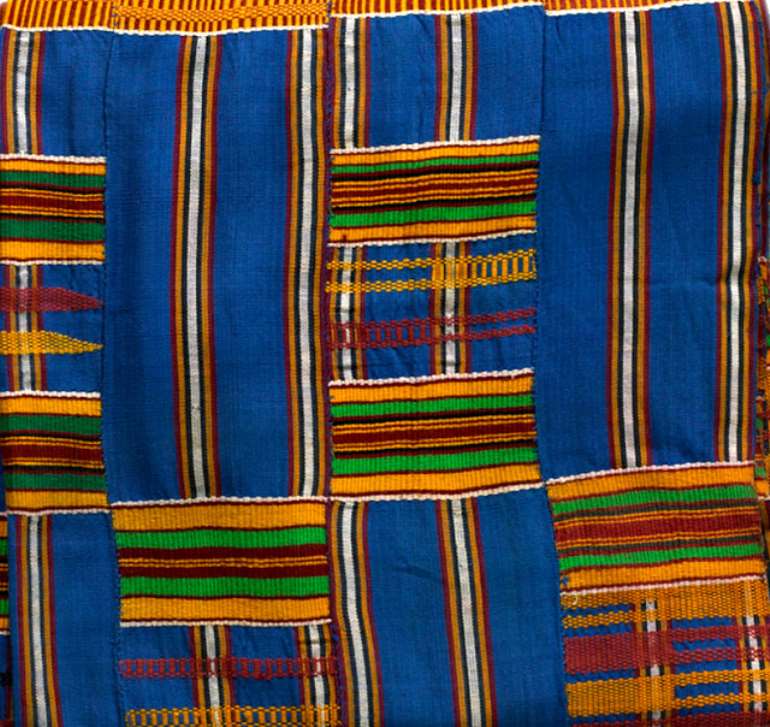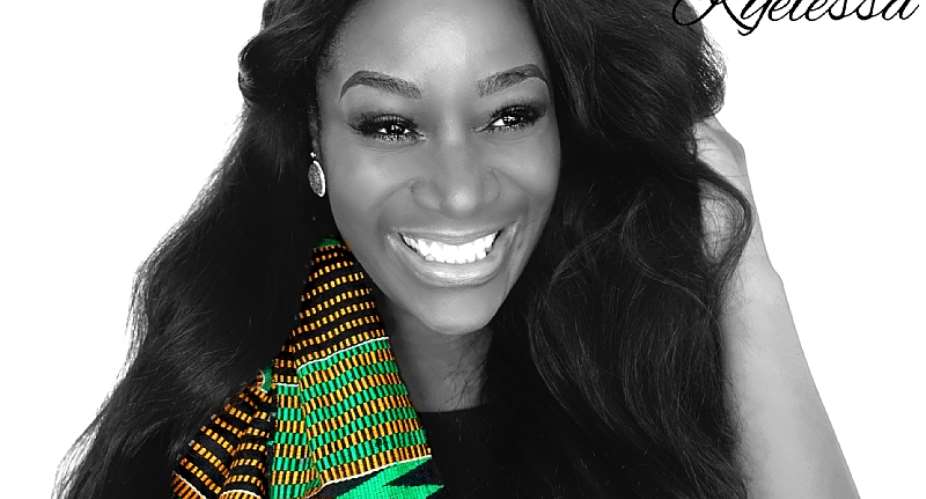Akwaaba! Or welcome to my gorgeous readers! I promised I would do a continuation of the first Ntoma article I wrote a while ago so here is me actually sticking to that promise. In case you missed the first article on the Ntoma Patterns and their Symbolism, just click "here". Anyways...this time around, your girl here decided to go a bit in-depth on the Kente fabrics. As a fashion aware individual that I am, I absolutely adore Kente fabrics. The material is of exquisite quality (feels heavy) and the colors are so insanely bright and popping! Kente fabrics also play a huge part in the core characteristics of the beautiful Ghanaian culture so here we go! (Photo below credits: Nyani Quarmyne "source").

So this is how the legend goes...Kente, also known as Nwentoma, actually originated in a village called Bonwire in Ghana approximately 375 to 400 years ago (17th century = 1600's upwards). According to literature, 2 brothers called Ameyaw and Kurugu went to hunt and they came across a spider weaving its web. Completely in awe, they decided to try to replicate this pattern and so they made the first cloth consisting of white and black fibers coming from a raffia tree. Up till today, the village Bonwire is still the center of Kente production. Now this cloth was presented to the Ashanti king, Nana Osei Tutu (reigned in early 1700's) at the time and he fell completely in love with the cloth. However, he believed that it would even be more breathtaking if there were actually colors in the cloth (in addition to the black and white). So, because there was no dye back then, Akwasi Opoku Agyeman (an outstanding popular weaver at the time), came up with the idea to use bark and seeds from local trees to create dyes. And this is how the key Kente colors came to life : black, green, red and yellow.

Yellow stands for gold, black stands for Africa, green stands for nature (forest) and red stands for the blood of our ancestors (forefathers). The first colorful Kente that was produced was called "Oyokoman" cloth and this was worn by Otumfuo Nana Prempeh I, an Ashanti King. Oyokoman was the name of the clan the former king belonged to. Kente was initially produced to be worn by the royals and the elite, simply because its manufacture was time consuming, tedious, and quality thread that was used to make this cloth is simply expensive (silk and cotton). However over the years, Kente has been made accessible to everybody (Photo below credits : Nyani Quarmyne "source").

MPUANKRON / COUNCIL OF ELDERS / 9 HEADS ARE BETTER THAN 1
Now this pattern you see down in the picture below, is a typical pattern that you'd find in a whole lot of "Fatia Fata Nkrumah" designs of Kente. Fatia was the wedded wife of the 1ste president of Ghana, Dr.Nkrumah. The Kente fabrics that were designed and produced in her honor, had democratic patterns to it. Council of elders also stands for 9 heads are better than 1, or 1 person cannot rule a land alone etc... Beautiful political tint. The color pink and violet stands for feminine characteristics such as calmness, tenderness, peace, humility, wisdom and patience. If you look at the inner square of the cloth, you'll notice it contains 5 mini yellow squares and 4 mini pink / violet squares, summing up to 9 squares in total (source image "here").

ATWEDE3 / LADDER
The design of this cloth is called "Edwene Si Edwene So", which means double wisdom. As you'll notice in this cloth, you'll see a pattern, the atwede3 that is woven here, looks more like a staircase than a ladder, and each pattern box contains 4 atwede3 symbols, they can be presented in 2 different colors at a time per pattern box. So atwede3 placed diagonal from each other are in the same color. Atwede3 should also not be confused with the Adinkra symbol Owuo Atwede3 which comes from the proverb "Owu Atwede3 Obako Mfro" which basically reflects on the mortal nature of human beings, at a certain point in time, everybody will climb the ladder of death (article on Adinkra symbols will come soon). This particular Adinkra symbol literally looks like a ladder, so that is not the symbol woven here in this Kente cloth. What you see here is more of a staircase looking atwede3.

NIATA / TWO EDGED SWORD
A two edged sword symbolizes the presence of both sides of a thing or a situation. Everything in life has its up but also its down sides, its favorable but also its unfavorable side. There's no such thing as "one side", both sides need to be present to come to one truth (the good and the bad). When you look at the pattern carefully, you'll see swords sliced in half and then placed opposite each other. This design strongly resembles the "Kyemfere" design, which comes from the proverb "Kyemfere Se Odaa Ho Akye, Na Onipa A Onwene No Nso Nye Den?" Translated this means: The Potsherd claims it has been here since forever, but what does the molder have to say then, the one that actually created the potsherd to begin with. That design symbolizes wisdom, patience, heirloom, knowledge and experience. The biggest difference in the designs is that with "Kyemfere", the parallelogram that connects the 2 sliced "swords" is not in the same color as the sliced swords. And in the "Niata" design, the half swords and the parallelogram connecting it are all in the same color. In this picture, you see the "Niata" pattern.

NKYIMKYIM / ZIG ZAG
This pattern symbolizes the dynamic characteristics of life. Nothing in life is static, everything and everybody is subjected to change. And change is not necessarily a bad thing. That goes without saying that there will most likely be storms along the way of this change, but it's supposed to be worth it at the end of it all. Change is good for growth. Truly love this symbolism, made an oversized bow from this cloth and just so I can pin it to any overall white or black dress for the perfect color block effect (as in top picture).

NTABON / OARS
This pattern was designed to express the following wise statement: a boat cannot move without united action of oarsmen. So it means that people need to work together to achieve progress, perseverance and unity.

FATIA FATA NKRUMAH
"Fatia Fata Nkrumah" literally means Fatia is a befitted wife for Nkrumah. This design was actually created in honor of the very First Lady of Ghana, wedded wife of president Dr.Nkrumah. This design was made very colorful and bright and is nowadays used for wedding ceremonies. Simply because it symbolizes good wife, unity, good marriage...etc. All in all, perfect for weddings.

ADWINASA
Adwinasa in this context means that all the motifs are messed up. The way this design came to life is quite an interesting story. The designer of this cloth back then wanted to create an unique motif that was not yet know to weavers at the time for the Asantehene... and so in his attempt to do so, he ended up using all motifs known to weavers and made a remark to the king that all the motifs known are exhausted. Therefor this design was held in quite a high esteem by the royals and elite. This design stands for royalty, excellence, creativity, wealth and elegance.

EMAA DA
"Emaa Da" means "It has never happened before". According to sources, when this design was created for an Asante king, he was in such awe that he literally named it just that. A design so beautiful that has never been created before.

SIKA FR3 MOGYA
"Sika Fr3 Mogya" means that money attracts blood, or could also be interpreted as money strengthens family bonds. When a member in a family becomes prosperous, it automatically becomes a responsibility of theirs to help the core and extended family.

ABUSUA Y3 ADOM
"Abusua Y3 Adom" means family is like a force. This design was created to celebrate the positive characteristics of a family union. Every member of a family is responsible for the physical protection, material & spiritual well-being and social security of the rest of the family members.

Well my dear readers, we have come to the end of this article. I realized when researching about the Kente fabrics, it was quite hard to find useful sources or even stores that could help me out. However if you are located in The Netherlands, there is a cozy little store in The Hague called Africa Sky where you can find a lot Nwentoma/ Kente and regular Ntoma, just click "here" to go to their website with contact details. And many thanks to Mr Charlie for the time and information offered. I and all my readers appreciate it! Do let me know which ones you like best xoxo.
Originating at www.eclectickyeiessa.com





 We’ll protect state wealth from opaque deals – Prof Jane Naana
We’ll protect state wealth from opaque deals – Prof Jane Naana
 Mauritania president says running for second term in June polls
Mauritania president says running for second term in June polls
 I won't ever say I was a mere driver’s mate' — Prof. Opoku-Agyemang
I won't ever say I was a mere driver’s mate' — Prof. Opoku-Agyemang
 2024 polls: 'EC struggling to defend credibility'— Prof. Opoku-Agyemang
2024 polls: 'EC struggling to defend credibility'— Prof. Opoku-Agyemang
 Akufo-Addo gov't's 'greed, unbridled arrogance, unrestrained impunity, sheer dis...
Akufo-Addo gov't's 'greed, unbridled arrogance, unrestrained impunity, sheer dis...
 Election 2024: Ghana needs an urgent reset, a leadership that is inspiring – Ma...
Election 2024: Ghana needs an urgent reset, a leadership that is inspiring – Ma...
 Partner NDC to rollout a future of limitless prospects – Prof Jane Naana Opoku-A...
Partner NDC to rollout a future of limitless prospects – Prof Jane Naana Opoku-A...
 NPP will remain in gov’t till Jesus comes — Diana Asamoah
NPP will remain in gov’t till Jesus comes — Diana Asamoah
 Sunyani Technical University demands apology from former SRC president over sex-...
Sunyani Technical University demands apology from former SRC president over sex-...
 'Dumsor' was resolved by Mahama but ‘incompetent' Akufo-Addo has destroyed the g...
'Dumsor' was resolved by Mahama but ‘incompetent' Akufo-Addo has destroyed the g...
